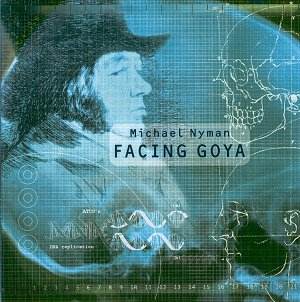How you respond to Facing Goya will almost certainly
depend on how much you like Michael Nyman’s brand of minimalism. As
the person usually credited with coining the term (at least in a musical
sense) he has, over a period of some twenty-five years, forged what
has now, rather ironically, become known as ‘post-minimalism’. What
this means in pure listening terms, I’m not quite sure (maybe it’s just
critics, who do love ‘tags’). What is certain is that if you are familiar
with almost any of his other scores, particularly the film scores for
Peter Greenaway, you will know what to expect. And you will get it -
in abundance.
What may trouble some people more is the story, a rather
curious, time-travelling concoction that tries hard to address serious
issues (genetics, cloning, racism), but constantly gets bogged down
in its own cleverness. Broadly speaking, it takes as its starting point
the dis-interment of the painter Goya’s headless body in 1888, and uses
a thriller-like narrative to take us on a search, back and forth in
time, for the missing skull. It ends with the discovery of the skull
and the subsequent attempt to clone the artist. All this may seem rather
sci-fi-like, but the deeper point is (according to the composer) that
the opera is a meditation on "the way scientists, geneticists,
politicians and artists use measurement to exclude, coerce and control
others". Some may detect a link here with his chamber opera of
1986, the Man Who Mistook his Wife for a Hat, and that neurological
case study does have similarities with Facing Goya. But the big
difference is that the previous opera worked, theatrically and on disc.
It had a taught construction, was concise in length and had a musical
texture that had a lightness and transparency not always evident in
his brasher scores. Goya is too long for its material, and Nyman’s
‘pop crossover’ tendencies are very much to the fore. Thus the opening
Prelude, a quite atmospheric, slowly lilting introduction, is followed
by Dogs Drowning in Sand, a pounding ‘aria’ that will either
grab you enthrallingly, or have you biting the carpet in frustration.
Actually, it reminded me somewhat of the wonderful opening counter-tenor
song At Last the Glittering Queen of Night, from The
Draughtsman’s Contract. But where Nyman’s Purcell-like canons and
pulsating ground basses fitted Greenaway’s artificial Restoration world
to perfection, here it simply goes on too long and gives the singers
a hard time trying to scream over it. The instrumental scoring is also
extreme-Nyman, with his characteristic amplified saxophones and solo
fiddles dominating the ensemble texture. In fact it occurred to me,
as I struggled to stay the course, that the musical structure is not
only based on repeated patterns within a single section, but the entire
opera seems made up of slowed down or speeded up versions of two or
three basic patterns. I know that is a fundamental principal of minimalism,
but Nyman really does seem to get away with murder in places.
The other big problem is his refusal to engage emotionally.
His music hardly ever allows for this, and it doesn’t particularly matter
much in most of the film scores he’s picked. But here I had the feeling
that he should pull back, give the listener respite, and maybe allow
his characters to identify with their situations. Of course, as with
much modern theatre, the multiple role-playing used here hardly encourages
this concept, and the overall effect is of a Brechtian alienation, or
emotional distancing, from the plight of the characters. It is possible
that the staging, which was originally at Santiago de Compostela, would
have helped resolve these issues, but the aural experience alone does
not help to assess the score sympathetically.
The singing is presumably what the composer intended
(the cast are all Nyman regulars) and does involve extremes of range
and pitch, virtuosic certainly, but so mechanical and steely-toned as
to be hardly an entirely pleasant listening experience. The work has
already come in for some hostile criticism; BBC Music Magazine found
it ‘cheap and cheerful … with numbingly repetitive rhythms and progressions
which make the common chord truly common’. Nyman fans will not be troubled
by this, and will probably already have the set. For those who, like
me, have been intrigued by his particular sound world for some years,
there simply may not be enough variation, or feeling that the composer
has moved on, to sustain real interest. The booklet is handsomely produced,
with essays by the composer, a critic and a doctor, all making a case
for the subject. I understand the set is medium-priced, which may help,
but one is left with the nagging sense that this really is for aficionados
only.
Tony Haywood
